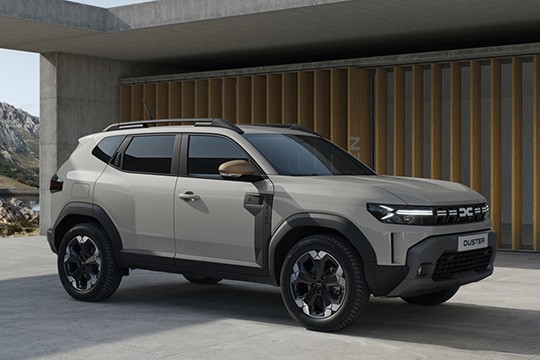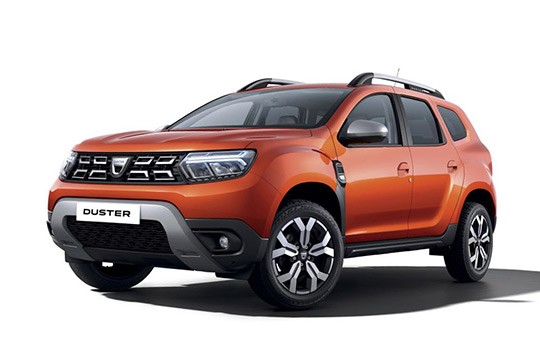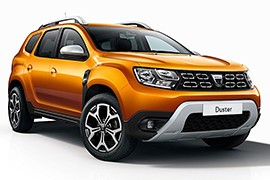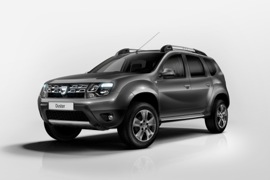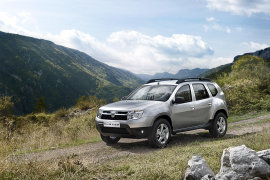DACIA Duster Models/Series Timeline, Specifications & Photos
First production year: 2010
Engines: Mild hybrid, Hybrid gasoline, Liquefied petroleum gas (lpg), Diesel, Gasoline, Natural gas
Body style: SUV (Sports Utility Vehicle)
Dacia introduced the third generation of the Duster in late 2023, surprising its customers with a vehicle that looked more premium than its predecessor.
What started as a mundane crossover became a top seller for the Romanian automaker. The Duster became a success regardless of whether it sported the Renault or the Dacia badge on it. In just 13 years, the car sold over 2.2 million units thanks to its rugged performance, low market price, and enough features to make it attractive for those wanting a simple SUV with or without an all-wheel drive system. The Romanian automaker produced the Duster at a rate of about one per minute, which was also impressive. In addition, the low running costs and simple maintenance helped the Duster keep its customers happy.
The car’s overall design was made around the Y letter, which was spotted on the front LED daytime running lamps that also doubled as turn signals and were integrated into the headlights that flanked the slim grille. But the most striking look was for the bumper, which featured an unpainted black center and lower area that was scratch-resistant. This new plastic element, named Starkle, which is made from 25% recycled materials. On the sides of the apron, the automaker added a set of fog lamps and, underneath the bumper, a plastic skid plate, depending on the trim level and options.
Dacia kept the same proportions for the Duster’s third generation, although the car was slightly lower than its predecessor. The profile was adorned on the wheel arches and on the front doors with the same Starkle material that was dyed in the mass during the process, meaning that it was scratch-resistant and didn’t show scrapes after an off-road session. The Duster looked sportier thanks to the blackened side pillars and the raked-forward tailgate. Furthermore, the automaker concealed the rear doors’ handles into the C-pillars. Another improvement for the vehicle was in the wheels department, where the automaker offered the car with an option of 18” alloys, which was unavailable on the Duster’s previous generations. Finally, the Y-shaped taillights at the back echoed the car’s main design language and the front headlights’ shapes.
Inside, Dacia created a cabin focused on practicality. Apart from the base trim level, all the others featured an LCD instrument cluster like on more expensive cars. Furthermore, a 10.1” touchscreen sat atop the center stack in a free-floating position. The Duster also sported a cradle for smartphones cramped between the infotainment’s display and the instrument cluster’s visor. For the front passengers, the automaker created new seats with embroidered Dacia logos on the seatbacks. Between them, the center console housed a couple of cup holders, a secondary support for a smartphone, and a wireless charger, available as an option. In the back, thanks to the CMF-B platform developed by Renault-Nissan, there was enough room for three occupants, although the transmission tunnel could limit legroom for the middle-seated one. Finally, at the back, the large trunk for this car’s segment could be expanded by lowering the split-folding (60/40) seatback of the bench seat.
Under the hood, the Duster 3 was the first not to feature a diesel option in the nameplate’s history. Instead, it was available with a choice of gasoline, mild-hybrid, or hybrid powertrains. Like in its previous generation, only versions fitted with front-wheel drive systems could be paired with an automatic transmission. Customers had to choose if they wanted 4x4 or auto boxes.
Dacia unveiled the refreshed version of its SUV model Duster in the summer of 2021, and apart from the visual updates, it brought some technological improvements.
Dacia was part of the Renault Group since 1999, and the French carmaker worked hard to make the unknown brand a European contender in the budget-car market. After the Logan sedan, the next best thing was the Duster, which it launched in 2010. Fast forward to 2017, and the Romanian SUV evolved into a second generation that shared most of its underpinnings with its predecessor, and four years later, it received a mid-life cycle impulse.
The car's exterior received an improved front fascia with the new Y-shaped signature daytime running lights introduced on the third generation of the Logan. The turn signals and the low-beam headlights featured LED lights as well. At the back, the redesigned rear spoiler slightly improved the fuel efficiency. Both front and rear plastic trims that mimicked an underbody shield sported a satin-chromed finish. At the back, the carmaker added new taillights, which also wore the Y-shaped signature lights.
Inside, the SUV featured a new infotainment system with an up to 8" touch-screen mounted on the center stack above the climate-control dials. Another improvement was for the center armrest, which was no longer attached to the driver's seat as before. Dacia also installed new headrests on the 2021 Duster.
Under the refreshed bodywork, it was the same platform used for the first Duster generation. The engine lineup lost the base, 95 hp turbo-diesel unit and retained only the 115 hp version. There were also four gasoline versions, starting with an inline-three turbocharged unit good for 90 horses, while the most potent version remained the 1.33-liter powerplant that provided 130 hp.
Dacia unveiled the second generation of its Duster SUV in 2017, and despite it sharing the same platform as its predecessor, it featured over 70% new parts.
The Romanian automaker was surprised by the huge number of orders it had with the previous Duster generation, which sold over one million units in just seven years. Maybe that number wasn't significant for some automakers, but for the small brand under Renault's umbrella was. So, the new generation had to meet customers' increased expectations.
At first glance, it looked more like a facelifted version of the Duster, but every body panel was new. In addition, the front fascia sported a fresh design with a honeycomb-style plastic grille and redesigned headlights. The new LED signature daytime running lights were divided into three parts on the outer sides of the headlamps. From its profile, the enlarged front fenders were continued by black plastic trims. On all-wheel drive versions, these sported a chromed 4x4 badge. In addition, the windshield was tilted even more than on its predecessor. Finally, at the back, the car featured new taillights with a cross-like design for the reversing lights.
Inside, the dashboard was new and sport as an option, an upgraded infotainment unit. In addition, the instrument cluster received a TFT display placed between the speedometer and tachometer, showing information from the onboard computer. Yet, strangely, the automaker kept the same seats and hard-plastic materials as its predecessor.
Under the hood, the automaker installed a new range of engines, depending on the market. Power went to the front or to all wheels, depending on the version.
The brand’s small SUV, the Duster was restyled for 2013 and a new engine was added to powerplants choices.
The Duster was a budget SUV that offered great practicality and even more space than most of its rivals on the market.
Of course, for the price of a supermini, the Duster did not offer cutting-edge technology or luxurious features, but offered more than expected.
For 2013, Dacia introduced the new 1.2-liter 4-cylinder gasoline engine that developed 125 hp and 205 Nm. The small SUV could reach 100 kph in around 10,4 seconds. The new engine was quiet and offered a comfortable ride.
The other two engines available were the 1.6-liter gasoline and the 1.5-liter diesel, both coming with an optional 4-wheel-drive system that was not available with the 1.2-liter TCE until 2015.
The 1.5-liter diesel engine was the correct choice in terms of power, as the other two might have felt a little underpowered. The diesel unit would get a little noisy if pushed.
The base version of the Duster was basic, however, the mid and the top-spec trim levels offered sufficient equipment to turn the Duster into an attractive choice.
Very spacious, the Duster offered great room for three adults in the rear seats, with decent legroom and headroom to enjoy a longer trip.
For 2013, the cabin was better insulated, as the for the previous models, the tire roll and the engine sound was a little disturbing.
The small and light Dacia Duster was one of the biggest success stories made by the Renault car-maker. It was introduced to the public at the 2010 Geneva Motor Show.
Dacia is a Romanian brand and it was bought by the Renault car-manufacturer in 1999. Previously, the Romanian brand built a licensed Renault 12. After the acquisition, the French management decided to build an affordable 4x4 SUV. And the result exceeded expectations.
The Dacia Duster was sold around the world as Renault Duster in Russia or South America or as a Nissan Terrano in India. Its round but the rugged look was appealing for customers. A slightly curved front end, a cabin with room for five, and a flat end were some of the car's external features.
Inside, the cloth seats could have been upgraded to man-made leather. The instrument cluster and the dashboard were inspired by other Renault and Dacia products. Depending on the trim level, it was available with manual or power windows, but no sunroof or climate control. It featured only air-conditioning.
From the technical point of view, the four-wheel independent suspension for the 4x4 model was a good addition, while the FWD version featured a trailing arm system. For the engines, the Duster was available with a 1.6-liter gasoline unit or with a 1.5-liter diesel. For the transmission, the Duster featured a 6-speed manual.
